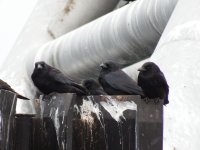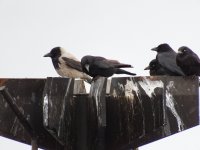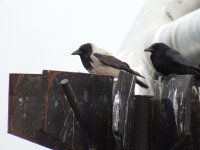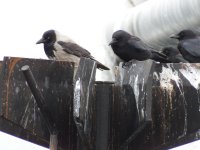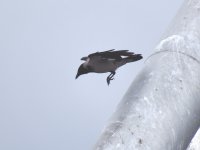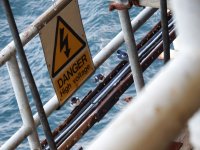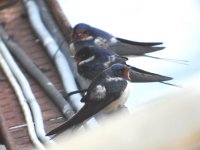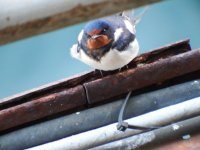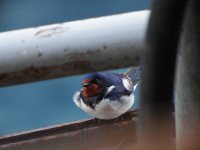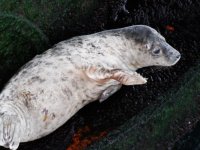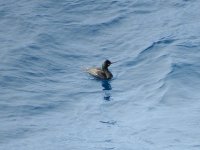Something to crow about.
As is now my habit before starting a nightshift, I popped up to the little access mezz between the helideck and the upper accommodation block, at about four thirty this afternoon. I usually creep up the stairway there until I can see the first part of the flat roof. Then I creep a little further up the stairs till I can see over some ducting and across to the rest of the flat roof. This has proven to be a very productive area for me, but not for the last few days. A cold wind from the north seemed to have stopped any bird movement, and even the GBBGs have moved on. This mornings total count was two Fulmar and a Gannet.
So as I poked my head up over the ducting this afternoon, I got a bit of a shock. My shock came in the form of an explosion of crows. There were crows everywhere. They scattered initially, then joined up in the air, wheeled around the platform then finally landed on the Pipe deck, approximately level with my position, but across the Skid deck that sits between the Accom block and the Drilling module upon which sits the Pipe Deck.
I started counting. Thirty four crows. My previous best for crows out here in the last twenty five years, was two. Now, as I scanned them I noticed two birds that stood out. Both had silver jackets. Hooded Crows - a lifer for me and a first for the platform.
I headed back into the accommodation block and looked up Hooded Crow. I was almost certain, but I had mistaken a hybrid for the real thing last year. By the time (17:15 hrs) I headed outside for my shift, I had convinced myself that I'd found two hybrids. There was no sign of the crows.
At about six, I went for a quick lap of the platform. Still no crows, but I did see a little bird that just evaded me by diving into the shadows of an in accessible area. It looked about the size of a Goldcrest, but seemed to have a dark olive back, and may have been slightly bigger than a GC. Another one that got away, but at least with the wind having turned to being a north westerly, I was starting to get birds again.
Later, at about seven this evening, I headed out and about again on my work rounds. I took a camera just in case. Reaching the Pipe Deck, I found the flock of crows again. They were perched out on the flare stack. I grabbed a few photos (see below) and am happy to say that two of the birds are indeed Hooded Crows. I have put the photos up on the Bird ID pages, just in case, but I'm sure they are Hooded.
The 2017 List Updated
1. Herring Gull
2. Great Black-Backed Gull
3. Glaucous Gull
4. Iceland Gull
5. Fulmar
6. Kittiwake
7. Long-Tailed Duck
8. Common Scoter
9. Gannet
10. Guillemot
11. Greylag Goose
12. Collared Dove
13. Goldcrest
14. Woodpigeon.
15. Peregrine
16. Sparrowhawk
17. Blackbird
18. Common Gull
19. Pied Wagtail*
20. Yellowhammer*
21. Goldfinch
22. Siskin
23. Robin
24. Rock Pipit
25. Ruff (d)*
26. Golden Plover
27. Swallow
28. House Martin*
29. Chiffchaff
30. Blackcap
31. Willow Warbler
32. Kestrel
33. Carrion Crow
34. Hooded Crow
As is now my habit before starting a nightshift, I popped up to the little access mezz between the helideck and the upper accommodation block, at about four thirty this afternoon. I usually creep up the stairway there until I can see the first part of the flat roof. Then I creep a little further up the stairs till I can see over some ducting and across to the rest of the flat roof. This has proven to be a very productive area for me, but not for the last few days. A cold wind from the north seemed to have stopped any bird movement, and even the GBBGs have moved on. This mornings total count was two Fulmar and a Gannet.
So as I poked my head up over the ducting this afternoon, I got a bit of a shock. My shock came in the form of an explosion of crows. There were crows everywhere. They scattered initially, then joined up in the air, wheeled around the platform then finally landed on the Pipe deck, approximately level with my position, but across the Skid deck that sits between the Accom block and the Drilling module upon which sits the Pipe Deck.
I started counting. Thirty four crows. My previous best for crows out here in the last twenty five years, was two. Now, as I scanned them I noticed two birds that stood out. Both had silver jackets. Hooded Crows - a lifer for me and a first for the platform.
I headed back into the accommodation block and looked up Hooded Crow. I was almost certain, but I had mistaken a hybrid for the real thing last year. By the time (17:15 hrs) I headed outside for my shift, I had convinced myself that I'd found two hybrids. There was no sign of the crows.
At about six, I went for a quick lap of the platform. Still no crows, but I did see a little bird that just evaded me by diving into the shadows of an in accessible area. It looked about the size of a Goldcrest, but seemed to have a dark olive back, and may have been slightly bigger than a GC. Another one that got away, but at least with the wind having turned to being a north westerly, I was starting to get birds again.
Later, at about seven this evening, I headed out and about again on my work rounds. I took a camera just in case. Reaching the Pipe Deck, I found the flock of crows again. They were perched out on the flare stack. I grabbed a few photos (see below) and am happy to say that two of the birds are indeed Hooded Crows. I have put the photos up on the Bird ID pages, just in case, but I'm sure they are Hooded.
The 2017 List Updated
1. Herring Gull
2. Great Black-Backed Gull
3. Glaucous Gull
4. Iceland Gull
5. Fulmar
6. Kittiwake
7. Long-Tailed Duck
8. Common Scoter
9. Gannet
10. Guillemot
11. Greylag Goose
12. Collared Dove
13. Goldcrest
14. Woodpigeon.
15. Peregrine
16. Sparrowhawk
17. Blackbird
18. Common Gull
19. Pied Wagtail*
20. Yellowhammer*
21. Goldfinch
22. Siskin
23. Robin
24. Rock Pipit
25. Ruff (d)*
26. Golden Plover
27. Swallow
28. House Martin*
29. Chiffchaff
30. Blackcap
31. Willow Warbler
32. Kestrel
33. Carrion Crow
34. Hooded Crow
Attachments
Last edited:




